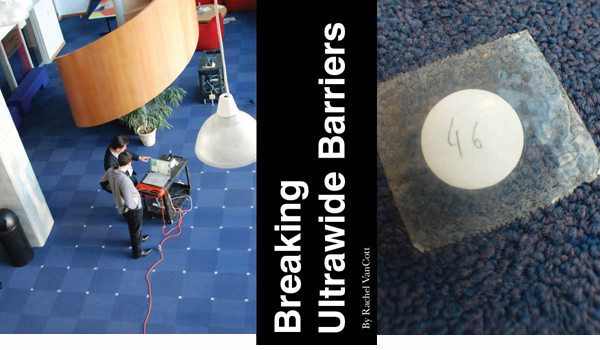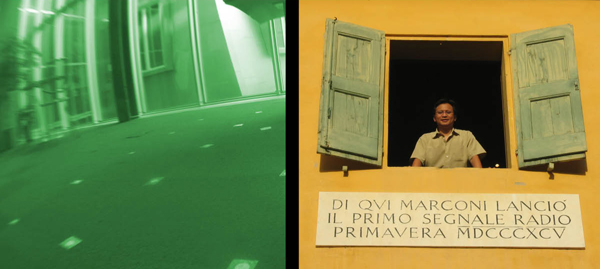

“Does it work?” asks a student in a blue shirt, who pauses to examine the experimental set up that occupies much of the lobby near LIDS headquarters. On this rainy afternoon, the checkered carpet is covered in carefully spaced, numbered, paper dots, and four utility carts, each with a small black radio transmitter box affixed to the top, are in position around the area.
“We’re putting it on each dot,” explains post-doctoral researcher Henk Wymeersch, gesturing to his laptop, which is perched on one of the carts, “and we’re going to collect the—”
“But does it work?” the student interjects.
This unique demonstration of a location-aware network is part of the third and final stage of a project led by Professor Moe Win, head of the Wireless Communications and Network Sciences group at LIDS. If it works, this trial will show for the first time that ultrawide bandwidth (UWB) radio signals can be used in practice to create cooperative location-aware networks. This type of network would offer a new way to track the position of a transmitter—and anyone holding that transmitter—even in settings where GPS doesn’t work.
It could be used in a military setting to track the position of each member of a team deployed within a building, or to give drivers a sense of direction in parking garages and “urban canyons”—where towering buildings block GPS signals. “This is the culmination of three years of our effort,” says Moe.
Other labs are equally eager to demonstrate use of the UWB radio technology, and they are also racing to show that it can be done. But LIDS has at least one advantage that no other lab can duplicate: Moe—a professor and experienced researcher who started working with UWB signals more than ten years before the technology was approved by the FCC for commercial use. “When I started working on ultra wideband, there were very few people working on this. Maybe five people across the country,” Moe recalls, “I used to know everybody. Now there’s a conference with hundreds of people just working on UWB, a special conference all for ultra wideband.”
Ultrawide bandwidth signals, unlike the normal “narrowband” radio that we’re more familiar with, are broadcast with very wide ranges of frequency, and require correspondingly lower power. Normal radio antennas can’t easily pick up UWB signals—which means that this technology has the potential to change the face of both commercial and clandestine communications.
Throughout the afternoon, Moe brings colleagues to see the demonstration and members of the lab take on the tedious business of moving the cart across the grid of dots in shifts. At each stopping point, the UWB transmitter mounted on the cart—the researchers call this transmitter “the agent”—sends signals to all other radios in range. The agent records how long it takes to get a response from the other radios, and tries to determine its position. The researchers can instantly see how well the agent’s guesses match its actual position.
The simulations that the team ran suggest that the agent should be better able to determine its position when it cooperates with other “agent” radios that are also wandering in the field, rather than relying only on radio transmitters that have a fixed, known, position. Halfway through the trial, they uncover a minor bug in the code, and the researchers head back to their desks to find and repair the problem. It’s a quick fix, but because of the error they have to start collecting data points all over again. Still, spirits are high. They have the answer. Yes, it works.
Professor Win and a team of undergraduate and graduate students from multiple departments competed in the Institute of Soldier Nanotechnologies (ISN) soldier design competition. In this contest they demonstrated a cooperative location-aware network for GPS-denied environments, using UWB technology, leading to the team winning the L3 Communications Prize.
Moe has been a professor of Aeronautics and Astronautics for seven years, and Moe says that he “lives” where his lab and students are—in LIDS. The professor completed his undergraduate studies at Texas A&M, his graduate work at the University of Southern California, and spent time at the Jet Propulsion Laboratory in California and at the AT&T Research labs in New Jersey before coming to teach at MIT.
Moe is proud that students in his lab are exposed to a range of scientific thought—they use theory to determine the best possible outcome in a given scenario, create algorithms to find practical ways to achieve this, and put the theory to the test through experimentation.
Because they carry their research all the way through, from theory to experimentation, the students must keep their theoretical assumptions realistic and relevant. The three-stage approach also creates the opportunity for undergraduates or less-experienced lab members to participate in leading-edge research that might otherwise be too theoretically complex, by participating in the experimental part of the research. “At the early stages in their career, [students] don’t necessarily have a very deep knowledge of theory, and it takes years to develop,” says Moe, “But if they are involved in some level of laboratory experimentation as part of the program, with senior students, it gives them an opportunity to have exposure to state of the art research early in their careers.”
Moe didn’t find his own love of engineering, mathematics, and experimentation until he was given a chance to work on a research project one summer, back when he was still an inexperienced undergraduate at Texas A&M. His junior lab members, such as Spencer Parra and Keone Hon, have less experience, but they make up for it with their dedication. “This isn’t just a drill problem,” Moe says, “[the undergraduates] are really involved in the forefront of this research.”
Cutting edge research comes with a price: long hours. Moe and Henk collect data until the evening, when many of the office lights in the Stata center have gone out.
Yuan Shen, one of Moe’s current Ph.D. students, worked on the theoretical end of this project and generated three academic papers as part of his master’s work—two of which have already been accepted by prestigious journals. Other members in the lab include Wesley Gifford and Watcharapan (Ae) Suwansantisuk. Wes has been the driving force behind getting much of the high precision measurement equipment working in the lab, and has developing an automated channel measurement apparatus. Ae is working on network synchronization, which aims to make clocks in the network tick at the same rate. Both Wes and Ae recently received a best paper award at an IEEE conference on next-generation wireless communications. “The students hold themselves to the highest standard,” says Moe.
Moe spends a lot of time with his students, in and outside of the lab. The group bonds on hiking and camping trips, and on weekends Moe cooks for the students who come by his house in search of academic help. They bring him problems and he offers guidance, home-cooked meals and barbecue delights. “I think that was what attracted me to the lab,” jokes Yuan. “Yuan asked me, ‘Can you give me your barbecue recipe? What’s your secret?” Moe says, laughing, “[I said] the day that I sign your thesis I’ll give you my secret recipe.”
Until then, Yuan and the members of Moe’s lab will just have to keep coming back to his enticing cookouts and pushing the boundaries of their field with their characteristic mix of theory, algorithms, and experimentation.
